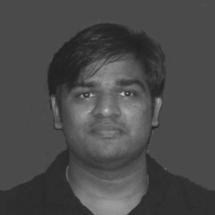
Anil Kannur
Work place: Department of Computer Science & Engineering, VTU Resource Research Center, Belagavi India
E-mail: anilkannur1978@gmail.com
Website: https://orcid.org/0000-0003-2492-1683
Research Interests: Computer systems and computational processes, Pattern Recognition, Image Compression, Image Manipulation, Image Processing
Biography
Mr. Anil Kannur, Research Scholar VTU Resource Research Center Belagavi, India. He
has obtained his B E in Computer Science & Engineering in 2001, M.Tech.(Computer Science & Engineering) in 2006 and presently perusing Ph.D. in Computer Science and Engineering (Registered under Visvesvaraya Technological University, Belagavi, India). He has published 10
research papers in peer reviewed International Journals and conferences. His research area of interest is Image Processing and Pattern Recognition.
Author Articles
A Hierarchical Support Vector Machines for Weapons Identification Using Multiple Stabbed Wound Images
DOI: https://doi.org/10.5815/ijigsp.2022.06.07, Pub. Date: 8 Dec. 2022
This paper proposes hierarchical support vector machines for weapon Identification using images of repeated stab wound patterns caused by sharp metal weapons used in homicidal cases and also presents a comparative study with standard flat support vector machine. The methodology includes the segmentation technique for the extraction of region-of-interest in the image using transition region-based segmentation algorithm and then texture, shape and size features were extracted from the segmented image. For multiple classes, a hierarchical support vector machine is adapted as a classifier. This approach gives a computationally interesting and efficient alternative solution to identify the weapons used in the crime; this method uses the digital images of repeated stab wound patterns which appear on the human body. The experimental study has three main stages, at the first stage includes generating of non-overlapping segments from the pattern, at the second stage the features of wound patterns are extracted and finally identification of patterns and its weapon of cause. The proposed method accuracy assessment is performed and also comparison study is performed with standard flat support vector machine and with the traditional method of forensic pathology. The experimental results achieved for Identification is 96.71% accuracy, with an available database of 500 images of a pattern consisting of repeated stabbed wounds. From the comparative study, the proposed methodology has given better results than standard SVM and traditional method. The proposed method delivers a better solution for identification from the image of the repeated stab wound pattern as there is no human intervention that reduces the error and data manipulation unlike traditional manual method.
[...] Read more.Hidden Markov Model for Identification of Different Marks on Human Body in Forensic Perspective
By Dayanand G Savakar Anil Kannur
DOI: https://doi.org/10.5815/ijmecs.2019.03.06, Pub. Date: 8 Mar. 2019
This paper proposes a computational forensic methodology which identify and classify different marks on the human body using Hidden Markov model. The methodology gives an efficient and effective computerized approach for the characteristics of different marks such as birthmarks, burntmarks, tattoos and weapons’ wounds found on human body. This proposed method will be a computationally effective substitution for the traditional forensic method in identifying the body marks in crime investigation of homicidal cases. Hidden Markov Model (HMM) is statistical and logical tool suitable for this identification. The marks on human body describe different patterns with characteristics that are helpful in identification. The experimental results achieved for identification of different marks with an average accuracy of 94.6%, on the available database of 400 images that includes four categories: Birthmarks, Burntmarks, Tattoos and weapons’ wounds (100 images of each marks). The methodology gives the better combination of features (color, texture and shape), which are extracted for the identification of marks on human body for the purpose of computational forensic science.
[...] Read more.Ensemble Learning Approach for Weapon Recognition Using Images of Wound Patterns: A Forensic Perspective
By Dayanand G Savakar Anil Kannur
DOI: https://doi.org/10.5815/ijigsp.2018.11.01, Pub. Date: 8 Nov. 2018
This paper presents a forensic perspective way of recognizing the weapons by processing wound patterns using ensemble learning that gives an effective forensic computational approach for the distinguished weapons used in most of crime cases. This will be one of the computational and effective substitutes to investigate the weapons used in crime, the methodology uses the collective wound patterns images from the human body for the recognition. The ensemble learning used in this proposed methodology improves the accuracy of machine learning methods by combining several methods and predicting the final accuracy by meta-classifier. It has given better recognition process compared to single individual model and the traditional method. Ensemble learning is more flexible in function and is better in the wound pattern recognition and their respective weapons as it overcomes the issue to overfit training data. The result achieved for weapon recognition based on wound patterns is 98.34%, from existing database of 800 images of pattern consisting of wounds of stabbed and gunshots. The authenticated experiments out-turns the preeminence of projected method over the widespread feature extraction approach considered in the work and also compares and suggest the false positive recognition verses false negative recognition. The proposed methodology has given better results compared to traditional method and will be helpful in forensic and crime investigation.
[...] Read more.Other Articles
Subscribe to receive issue release notifications and newsletters from MECS Press journals